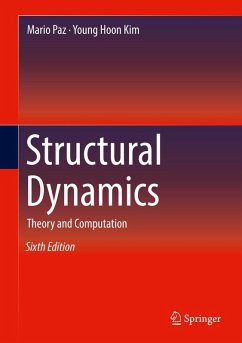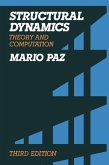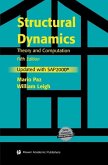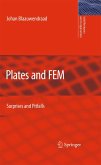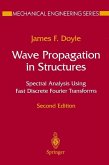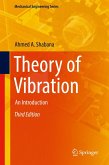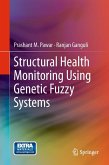

Alle Infos zum eBook verschenken

- Format: PDF
- Merkliste
- Auf die Merkliste
- Bewerten Bewerten
- Teilen
- Produkt teilen
- Produkterinnerung
- Produkterinnerung

Hier können Sie sich einloggen

Bitte loggen Sie sich zunächst in Ihr Kundenkonto ein oder registrieren Sie sich bei bücher.de, um das eBook-Abo tolino select nutzen zu können.
The sixth edition of Structural Dynamics: Theory and Computation is the complete and comprehensive text in the field. It presents modern methods of analysis and techniques adaptable to computer programming clearly and easily. The book is ideal as a text for advanced undergraduates or graduate students taking a first course in structural dynamics. It is arranged in such a way that it can be used for a one- or two-semester course, or span the undergraduate and graduate levels. In addition, this text will serve the practicing engineer as a primary reference. The text differs from the standard…mehr
- Geräte: PC
- ohne Kopierschutz
- eBook Hilfe
- Größe: 23.6MB
![Structural Dynamics (eBook, PDF) Structural Dynamics (eBook, PDF)]() Mario PazStructural Dynamics (eBook, PDF)113,95 €
Mario PazStructural Dynamics (eBook, PDF)113,95 €![Structural Dynamics (eBook, PDF) Structural Dynamics (eBook, PDF)]() Mario PazStructural Dynamics (eBook, PDF)105,95 €
Mario PazStructural Dynamics (eBook, PDF)105,95 €![Wave Propagation in Structures (eBook, PDF) Wave Propagation in Structures (eBook, PDF)]() James F. DoyleWave Propagation in Structures (eBook, PDF)40,95 €
James F. DoyleWave Propagation in Structures (eBook, PDF)40,95 €![Plates and FEM (eBook, PDF) Plates and FEM (eBook, PDF)]() Johan BlaauwendraadPlates and FEM (eBook, PDF)59,95 €
Johan BlaauwendraadPlates and FEM (eBook, PDF)59,95 €![Wave Propagation in Structures (eBook, PDF) Wave Propagation in Structures (eBook, PDF)]() James F. DoyleWave Propagation in Structures (eBook, PDF)73,95 €
James F. DoyleWave Propagation in Structures (eBook, PDF)73,95 €![Theory of Vibration (eBook, PDF) Theory of Vibration (eBook, PDF)]() Ahmed A. ShabanaTheory of Vibration (eBook, PDF)73,95 €
Ahmed A. ShabanaTheory of Vibration (eBook, PDF)73,95 €![Structural Health Monitoring Using Genetic Fuzzy Systems (eBook, PDF) Structural Health Monitoring Using Genetic Fuzzy Systems (eBook, PDF)]() Prashant M. PawarStructural Health Monitoring Using Genetic Fuzzy Systems (eBook, PDF)73,95 €
Prashant M. PawarStructural Health Monitoring Using Genetic Fuzzy Systems (eBook, PDF)73,95 €-
-
-
The revised version will include:
· solved 34 examples in Chapters 1 through 22 along with MALAB codes.
· basics of earthquake design with current design codes (ASCE 7-16 and IBC 2018).
· additional figures obtained from MATLAB codes to illustrate time-variant structural behavior and dynamic characteristics (e.g., time versus displacement and spectral chart).
Dieser Download kann aus rechtlichen Gründen nur mit Rechnungsadresse in A, B, BG, CY, CZ, D, DK, EW, E, FIN, F, GR, HR, H, IRL, I, LT, L, LR, M, NL, PL, P, R, S, SLO, SK ausgeliefert werden.
- Produktdetails
- Verlag: Springer-Verlag GmbH
- Seitenzahl: 634
- Erscheinungstermin: 28. November 2018
- Englisch
- ISBN-13: 9783319947433
- Artikelnr.: 59930340
- Verlag: Springer-Verlag GmbH
- Seitenzahl: 634
- Erscheinungstermin: 28. November 2018
- Englisch
- ISBN-13: 9783319947433
- Artikelnr.: 59930340
Es gelten unsere Allgemeinen Geschäftsbedingungen: www.buecher.de/agb
Impressum
www.buecher.de ist ein Shop der
buecher.de GmbH & Co. KG
Bürgermeister-Wegele-Str. 12,
86167 Augsburg
Amtsgericht Augsburg HRA 13309
Persönlich haftender Gesellschafter: buecher.de Verwaltungs GmbH
Amtsgericht Augsburg HRB 16890
Vertretungsberechtigte:
Günter Hilger, Geschäftsführer
Christian Sailer, Geschäftsführer
Sitz der Gesellschaft:Augsburg
Ust-IdNr. DE 204210010
Bitte wählen Sie Ihr Anliegen aus.
Rechnungen
Retourenschein anfordern
Bestellstatus
Storno
Sollte Ihr Anliegen nicht dabei sein, finden Sie weitere Auskünfte zu Ihren Fragen auf unseren Serviceseiten.
